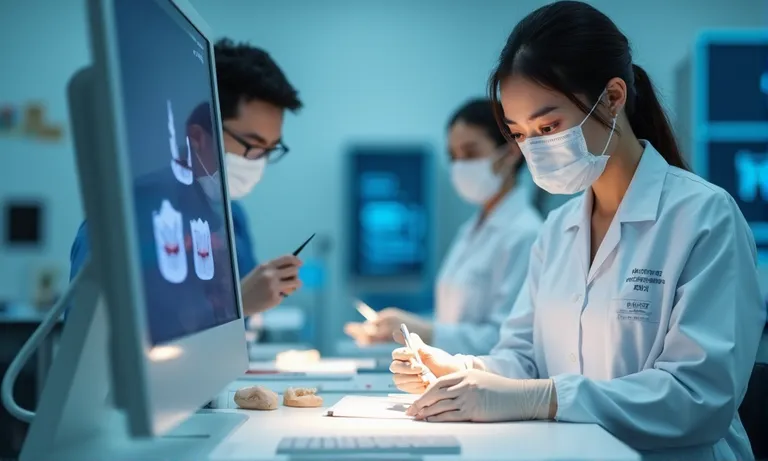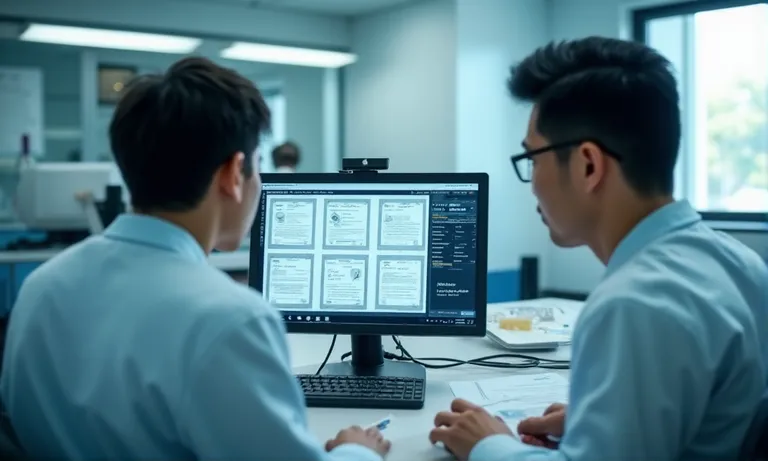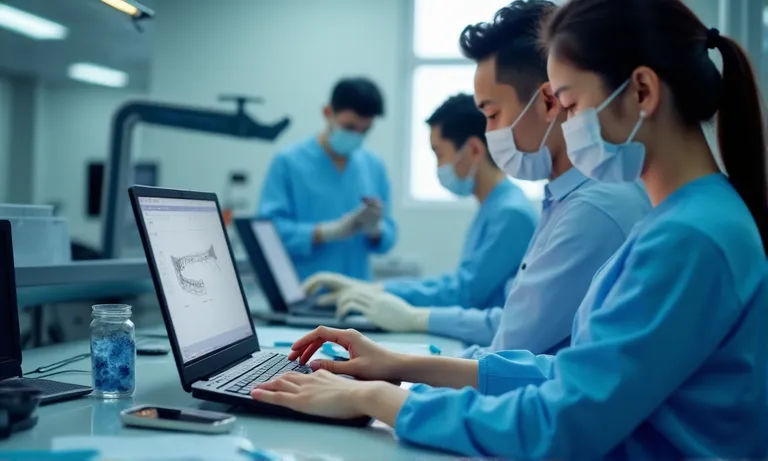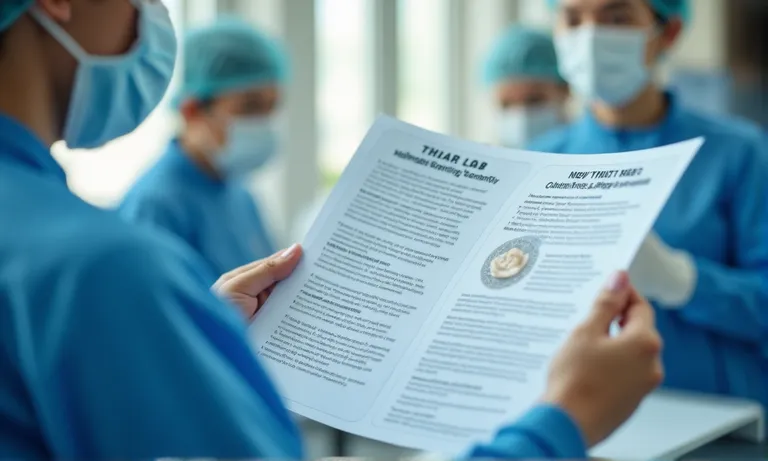Sourcing crown and bridge restorations from Chinese dental labs can deliver cost savings and production scalability—but success depends on setting clear expectations and selecting the right partners. While China’s dental lab industry has evolved with advanced digital workflows and high-volume capacity, buyers must balance opportunities with proactive risk management.
Procurement teams under pressure to ensure consistent quality, digital integration, and agile turnaround are increasingly exploring offshore options. To navigate this landscape effectively, this guide highlights key insights for decision-makers:
- Why global buyers look to China: market trends, cost advantages, and digital readiness
- What defines a reliable partner: QA systems, certifications, and workflow compatibility
- Common risks to address: quality consistency, communication gaps, and hidden logistics costs
- How to test collaboration: pilot orders, detailed SLAs, and escalation protocols
- When to combine offshore labs with local suppliers for hybrid efficiency
This article offers a practical, neutral perspective to help buyers identify credible Chinese dental labs, avoid costly missteps, and establish long-term partnerships with confidence.
Why More Dental Buyers Are Turning to Chinese Crown & Bridge Labs: The Strategic Shift
The global dental supply chain is undergoing a strategic transformation as buyer seek greater cost-efficiency, scalability, and technological alignment. From independent clinics to large DSOs and distributors, more dental professionals are partnering with Chinese crown and bridge labs to meet rising patient demands without compromising quality. This shift reflects not just economic considerations but also a broader rethinking of global supply chain dynamics in dentistry.

Dental-buyers-outsourcing-to-Chinese-crown-and-bridge-labs
What global trends are driving outsourcing to China?
Global dental buyers are under increasing pressure to optimize supply chain flexibility and reduce operational costs. Labor shortages, rising wages, and higher equipment investment in Western markets have accelerated the search for offshore partners.
Key trends include:
- Escalating local costs: Labor and overhead costs in Western countries have grown by 15–25% over the past five years, eroding profit margins for clinics and distributors.
- Improved global logistics: Trade agreements and advancements in shipping infrastructure now allow dental prosthetics to move across borders in as little as 3–5 days, with reliable tracking.
- Digital workflow adoption: CAD/CAM and 3D printing technology enable seamless cross-border collaboration, reducing errors and turnaround time.
These factors make China an attractive production hub for global dental networks.
What advantages do Chinese labs offer in cost, capacity, and scalability?
✅ Cost-efficiency with uncompromised quality
Compared to Western labs, Chinese labs can deliver crown and bridge work at 30–50% lower costs, thanks to optimized labor and production systems, while still adhering to international material and craftsmanship standards.
✅ High-capacity manufacturing
With the ability to process up to 10,000 cases per month, top-tier Chinese labs are well-equipped to support DSOs and distributors managing multi-clinic operations.
✅ Flexible scaling for peak demand
Chinese labs can dynamically adjust production volumes to accommodate seasonal surges or large batch orders, minimizing delays and stockouts.
Which types of clients see the most benefit from offshore sourcing?
Regional distributors: Offshore production augments local supply chains, allowing distributors to fulfill bulk orders quickly and cost-effectively. One distributor noted how seamless it was to integrate our production into their fulfillment system during peak demand periods, avoiding backlogs and keeping their clients happy.
Dental Service Organizations (DSOs): Centralized procurement and standardized quality control make Chinese labs ideal partners for DSOs operating across large networks. One of our DSO clients was delighted to see that, while maintaining strict quality standards, their overall crown & bridge workflow became noticeably smoother. With fewer production bottlenecks and faster case turnaround, they reported significant operational relief. Based on their scale and order volume, we estimate their cost optimization to be around 20–40%.
Independent clinics: Smaller practices can access affordable solutions for crown and bridge work, enabling them to compete with larger players on price and turnaround time. For instance, one European clinic told us they were impressed by the consistent fit and finish of the prosthetics, and the ability to serve more patients without increasing local lab costs.
✅ Chinese dental labs have emerged as strategic partners for buyers balancing cost, quality, and scale – TRUE
With advanced workflows, international certifications, and affordable production models, they align seamlessly with the needs of global procurement teams.
❌ Offshore labs cannot meet modern quality expectations – FALSE
Reputable Chinese labs comply with ISO and FDA certifications, integrating digital systems for consistent, high-quality results.
Key Opportunities in Working with China-Based Crown & Bridge Labs
Partnering with Chinese crown and bridge labs opens up a new level of strategic advantage for dental buyers worldwide. From lowering production costs to adopting advanced digital workflows and scaling to high-volume production, these opportunities allow procurement teams to transform their supply chains for the future of dentistry.

Opportunities-of-working-with-Chinese-crown-and-bridge-labs
Cost efficiency without compromising material and workmanship quality
Chinese dental labs offer highly competitive pricing, driven by economies of scale and optimized labor structures. These savings don’t require any trade-offs on quality—many labs source FDA-approved and CE-certified materials to meet stringent international standards.
One European distributor told us they were surprised to find that their monthly crown procurement costs dropped significantly after transitioning part of their workload offshore. While they didn’t share precise figures, based on the volume and price differential, we estimate they achieved 20–35% cost savings while maintaining the same material quality.
High-volume capacity and batch delivery capabilities
For dental buyers managing multiple clinics or extensive distribution networks, capacity is critical. Many leading labs in China are designed for mass production, with systems capable of processing 10,000+ cases per month.
A DSO procurement manager shared that their internal team had struggled to keep up with peak demand cycles during Q4. After partnering with our factory, they reported feeling “relieved” at how seamlessly large batch orders were fulfilled and delivered on a rolling schedule. This flexibility allowed them to scale their operations without adding pressure to their local lab teams.
Access to advanced digital workflows with global case compatibility
Modern Chinese dental labs are not just keeping up with global technology—they are helping to democratize it. By integrating scanner compatibility, CAD/CAM systems, and cloud-based collaboration tools, they enable error-free cross-border case transfers and efficient workflows.
Key insight: “Technical parity”
This trend reflects a shift we call “technical parity”, where offshore labs are no longer seen as “low-tech” options. Instead, they actively drive the adoption of digital workflows for clinics worldwide, making advanced technology more accessible even for smaller practices.
✅ Chinese dental labs can deliver cost savings and high-volume production with robust digital integration – TRUE
Strategic buyers leverage these capabilities to scale operations without sacrificing quality.
❌ Offshore labs are only suited for low-complexity cases – FALSE
Reputable labs in China now handle complex full-arch restorations and use advanced systems that match or exceed many local labs’ capabilities.
Hidden Risks and Common Pitfalls in Offshore Lab Sourcing
While partnering with overseas dental labs can unlock significant advantages, buyers must also be aware of hidden risks that, if left unaddressed, could impact quality, timelines, and regulatory compliance. Recognizing these challenges—and implementing mitigation strategies—helps build secure, reliable, and future-proof supply chains.

Risks-and-pitfalls-in-offshore-dental-lab-sourcing
Communication misalignment and time-zone delays
Working across different time zones can create communication lags, particularly during urgent case adjustments. Misunderstandings over technical requirements or priority orders can lead to costly delays.
💡 Lesson from the field: One independent clinic shared their frustration after a critical case was delayed because last-minute changes weren’t communicated in time. The lab worked diligently, but time-zone differences caused a full day’s lag in implementing the adjustments.
✅ Our recommendation: Use shared project management platforms (e.g., Asana, Monday.com) and establish clear protocols for daily check-ins or milestone confirmations. A “follow-the-sun” communication model ensures nothing stalls overnight.
Quality variability without enforceable QA protocols
Not every offshore lab maintains consistent quality without robust QA processes. Variability in workmanship or material standards can result in high remake rates and patient dissatisfaction.
💡 Cautionary tale: A regional distributor partnered with a low-cost lab promising ultra-fast delivery. While initial batches were satisfactory, they later encountered a 15% remake rate due to ill-fitting crowns and non-uniform shading. The hidden costs of remakes, expedited shipping, and loss of client trust outweighed their initial savings.
✅ Our recommendation: Conduct a comprehensive QA audit during onboarding. Request documentation of ISO, FDA, or CE certifications and set clear tolerances and return/rework policies.
Turnaround and logistics unpredictability
International shipping introduces variables like customs delays and unpredictable transit times. A lack of logistics expertise can result in extended lead times and disrupted treatment schedules.
💡 What we’ve seen: A DSO client previously worked with a lab that didn’t have dedicated logistics partners. During peak season, cases sat at customs for nearly a week, leaving the clinics scrambling for alternative solutions.
✅ Our recommendation: Choose labs with established global logistics networks or in-house clearance teams. Work with partners who offer contingency plans for urgent cases, such as partial shipments or priority courier services.
Regulatory and material compliance concerns
Strict regulations in many markets mandate certified materials for dental restorations. Non-compliance can trigger legal issues, patient safety concerns, and reputational damage.
✅ Our recommendation: Confirm that the lab uses FDA-approved, CE-certified, or locally compliant materials. Request material batch records and periodic compliance reports for added assurance.
✅ Understanding and addressing offshore risks ensures smoother partnerships – TRUE
Proactive buyers work with labs that invest in communication, quality systems, and compliance infrastructure.
❌ All offshore labs are unreliable by default – FALSE
Reputable Chinese labs have robust QA protocols, digital systems, and logistics expertise to support global clients successfully.
How to Evaluate and Select a Trustworthy Chinese Lab Partner
Identifying the right Chinese dental lab partner requires careful due diligence to ensure quality, reliability, and seamless collaboration. A structured evaluation process reduces potential risks and builds confidence for long-term cooperation.

Evaluating-and-selecting-a-Chinese-dental-lab-partner
To help you systematically vet potential partners, we’ve developed the C.R.E.A.T.E. Evaluation Model. This framework transforms a complex due diligence process into six key, actionable dimensions:
- C – Certifications & Compliance: Go beyond simply asking for certifications. Verify their validity and scope. Ensure the lab holds internationally recognized certifications such as FDA, CE, or ISO 13485. Also, check their compliance records for material sourcing and production processes.
- R – References & Reliability: Request references from existing international clients. Ask for more than just a positive review; inquire about how the lab handled challenges or disputes to gauge their crisis management capabilities and long-term reliability.
- E – Expertise & Equipment: Assess the technical proficiency of their team and verify their use of modern technology, such as the latest CAD/CAM systems, 3D printers, and 5-axis milling machines. A lab that invests in technology is often a more reliable, forward-thinking partner.
- A – Agile Adjustments & Accuracy: Use a trial order to test their responsiveness. Evaluate their accuracy in areas like color matching and marginal fit, and assess how quickly and effectively they respond to feedback or requests for adjustments.
- T – Transparency & Technology: Confirm the lab provides material traceability reports to ensure every batch of materials is verifiable. Evaluate their digital workflow to see if it integrates seamlessly with your LIMS or practice management software, allowing for easy data sharing and version control.
- E – Economics & Efficiency: Look beyond a single low price. Evaluate the total cost of ownership by factoring in turnaround times, logistics efficiency, and potential hidden costs from remakes or delays.
By using the C.R.E.A.T.E. model, you can systematically score potential partners and make a data-driven decision, helping you avoid operational surprises and build a solid foundation for collaboration.
Managing Digital Workflow Integration Across Borders
Seamless digital integration is no longer a luxury—it’s the foundation of successful collaboration between global dental buyers and Chinese labs. Aligning systems and workflows ensures case accuracy, faster turnaround, and minimizes cross-border friction, enabling procurement teams to scale operations with confidence.

Digital-workflow-integration-between-overseas-dental-buyers-and-Chinese-labs
Ensuring compatibility with scanners, software, CAD/CAM systems
Modern Chinese labs increasingly support global CAD/CAM standards, accepting STL, PLY, and DICOM file formats. Verifying compatibility upfront prevents frustrating delays later in the process.
One European clinic reported that, after switching to a lab fully compatible with their iTero scanner and Exocad software, they reduced file transfer errors by 18%, significantly improving first-pass success rates for crown designs.
Synchronizing cloud portals, file version control, and communication platforms
- Cloud portals: Enable real-time case updates, reducing email clutter and speeding up approvals.
- File version control: Prevents outdated or incorrect iterations from being used in production.
- Communication platforms: Tools like Teams, Slack, or WeChat ensure instant feedback across time zones.
💡 Case example: A DSO using a shared cloud portal with our factory noted their overall turnaround time dropped by 3 days, thanks to faster approvals and fewer back-and-forth corrections.
Designing SOPs for seamless digital collaboration
Establishing Standard Operating Procedures (SOPs) is critical to prevent bottlenecks and ensure consistency. A robust SOP might include:
- File naming conventions: e.g., ClinicName_CaseID_Date.stl to avoid confusion.
- Upload/download protocols: Secure transfer methods to maintain data integrity.
- Approval workflows: Define roles—who reviews designs, who gives final approval.
- Urgency escalation paths: Clear steps for addressing critical cases or last-minute adjustments.
💡 Why it matters: SOPs don’t just streamline workflows—they also give both buyers and labs a shared framework for accountability.
🔮 Future trends: AI and automation in digital workflows
Looking ahead, artificial intelligence (AI) is poised to redefine digital collaboration:
- AI-assisted design: Labs are beginning to use AI tools that suggest optimal crown morphologies and detect potential occlusion issues before production.
- Automated defect recognition: Algorithms can flag errors in STL files, saving time and reducing remake rates.
- Predictive logistics: AI systems analyze case flow data to anticipate bottlenecks and recommend adjustments proactively.
💡 Key insight: Forward-thinking labs are already adopting these tools to further cut turnaround times and improve accuracy—a trend that will only accelerate.
✅ Cross-border digital workflows enable accurate, efficient collaboration with Chinese labs – TRUE
Well-integrated systems minimize delays and boost buyer confidence in remote production.
❌ Digital integration is optional for offshore lab partnerships – FALSE
In today’s workflows, digital compatibility isn’t a luxury—it’s mission critical.
Mitigating Risk Through Trial Orders and Clear SLA Mechanisms
When partnering with overseas dental labs, a well-structured trial phase and clear Service Level Agreements (SLAs) are essential for minimizing risk. These measures allow buyers to validate workflows, assess quality, and establish mutual expectations before scaling up orders, laying the foundation for a sustainable, low-friction partnership.

Trial-orders-and-SLA-mechanisms-with-Chinese-dental-labs
Structuring pilot cases to validate workflow and quality
Pilot cases are more than just test runs—they are strategic tools for assessing a lab’s technical capabilities and communication efficiency under real-world conditions.
Best practices for trial orders:
- Diverse case selection: Include both simple crowns and moderately complex bridges to test consistency across case types.
- Set clear evaluation criteria: Assess margin accuracy, color matching precision, and turnaround reliability.
- Track feedback meticulously: Document adjustments and remakes during the trial phase to gauge how the lab responds to real-time feedback.
💡 Our insight: Buyers who approach trial orders systematically often uncover hidden strengths and potential pain points early—saving considerable time and cost later.
Defining clear SLAs for quality, remake policy, turnaround, and logistics
An SLA is not just a contract—it’s a shared roadmap for how both sides will work together.
Key SLA components:
- Quality standards: Specify acceptable tolerances and confirm use of FDA-approved, CE-certified materials.
- Remake policy: Define conditions for remakes and set approval timelines. Example: One buyer avoided a potential dispute over a shade mismatch thanks to an SLA that required “48-hour remake approval,” enabling the lab to quickly correct the issue and keep treatment schedules intact.
- Turnaround times: Establish realistic timeframes for standard and rush cases.
- Logistics: Clarify shipping methods, tracking expectations, and customs support responsibilities.
Establishing escalation protocols and dispute resolution processes
No matter how robust the systems, unforeseen issues may arise. Escalation protocols in the SLA ensure that both parties know how to resolve challenges swiftly and fairly.
Suggested escalation steps:
- Immediate notification of issues within 24 hours.
- Designated points of contact for urgent matters.
- Agreed timelines for resolution based on case criticality.
Building Partnerships on a Solid Foundation
Starting with well-designed pilot orders allows buyers to assess alignment on quality and workflow. Detailed SLAs, with clear definitions for production, delivery, and communication expectations, create transparency and mutual accountability. By incorporating escalation and resolution pathways, buyers and labs can confidently navigate the complexities of cross-border collaboration and focus on scaling success.
Trial phases and SLAs are not just safeguards—they are the blueprint for building strong, reliable partnerships with Chinese labs
Comparing Chinese Labs vs Local/Regional Providers: A Strategic View
Choosing between offshore and local dental labs requires a nuanced understanding of trade-offs in cost, logistics, and operational flexibility. Strategic buyers evaluate these differences to balance efficiency with responsive

Comparing-Chinese-dental-labs-and-local-regional-providers
When does offshore sourcing outweigh local lab advantages?
Chinese labs offer significant cost savings and scalability, especially for large-volume orders. For buyers prioritizing price efficiency and standardized production, offshore sourcing often provides a clear advantage.
Trade-offs in logistics, support access, and iteration speed
Logistics: International shipping adds lead time and potential customs challenges.
Support access: Local labs offer face-to-face consultations and immediate support for adjustments.
Iteration speed: Local providers may execute urgent changes faster than offshore partners.
How hybrid models combine offshore efficiency with local agility
Some buyers use hybrid models, sourcing standard cases offshore while retaining complex or time-sensitive work with local labs. This approach optimizes cost without sacrificing flexibility.
Key Takeaways
Offshore labs excel in cost efficiency and production scalability for high-volume needs.
Local providers offer agility and personal support, which benefits time-critical cases.
A hybrid sourcing strategy can balance price, speed, and quality effectively.
For buyers exploring offshore collaboration, evaluating Chinese dental labs as part of a blended approach can deliver both efficiency and adaptability
Long-Term Success Factors in China-Based Dental Lab Partnerships
Sustainable partnerships with Chinese dental labs require more than competitive pricing; they depend on reliable systems, proactive collaboration, and alignment with global practice workflows. Buyers focusing on these success factors can achieve consistent quality and operational efficiency over time.

Long-term-success-in-China-dental-lab-partnerships
Identifying labs with repeat order systems and digital SOPs
Labs using structured systems for repeat orders can deliver consistent quality and meet agreed timelines. Standard operating procedures ensure both parties work from the same expectations.
Evaluating integration readiness with your LIMS/practice systems
Seamless integration with laboratory information management systems (LIMS) or practice management software minimizes friction and enhances communication throughout case processing.
Recognizing signs of long-term reliability and proactive collaboration
Transparency in communication: Regular updates and issue reporting build trust.
Investment in technology: Labs adopting modern tools stay aligned with global standards.
Flexible support: A willingness to adapt to client-specific requirements is key.
Key Takeaways
Prioritize labs with structured systems for repeat orders and digital workflow integration.
Evaluate the lab’s readiness to collaborate with your software ecosystem.
Long-term reliability depends on transparency, technological capability, and adaptability.
As an overseas dental lab, we focus on supporting partners with robust systems and a collaborative approach, helping them achieve sustained success in a competitive global market. For buyers seeking stable supply chains, long-term partnerships offer measurable operational advantages.
Conclusion
Sourcing crown and bridge restorations from Chinese dental labs offers dental buyers a balance of cost efficiency, scalable production, and advanced digital workflows. By carefully selecting partners with robust quality systems and clear communication channels, buyers can mitigate common offshore risks and build reliable supply chains. As an overseas dental lab, we support global clients with structured processes, material transparency, and flexible collaboration to ensure consistent results. Long-term partnerships anchored in trust and aligned workflows deliver measurable operational advantages in today’s competitive dental market.


